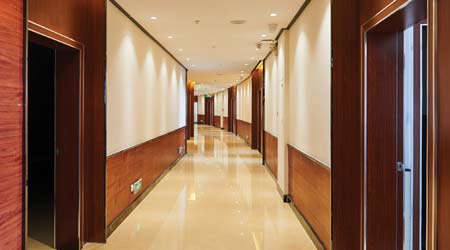 Advances in LED lighting can deliver benefits that include color tuning, white light color tuning, aesthetics, controllability and the ability to collect data via sensors.
Advances in LED lighting can deliver benefits that include color tuning, white light color tuning, aesthetics, controllability and the ability to collect data via sensors.Lighting Controls: When to Use TLED Lamps
Among other scenarios, TLED lamps are ideally suited for commercial and institutional facilities when a manager may have a limited budget and is spot relamping a large facility
TLED considerations
TLED lamps are ideally suited to applications where a manager wants to maintain a similar space appearance with the existing luminaires in good condition, has a limited budget, and is spot relamping a large facility, or where access to the ceiling is limited, making luminaire replacement difficult.
The complete unit integrates the light source, optics and heat sinking. The majority are bi-pin T8 lamps designed to replace 2-foot, 4-foot, and U-bend T8 and T12 lamps, though some target T5 and T5 high-output lamps. While some lamps imitate the distribution and appearance of fluorescent lamps, most of them are directional.
TLED lamps are typically classified as UL Type A, B and C, all of which are compatible with automatic shutoff controls — e.g., wired or wireless occupancy or light sensors, panelboard upgrades — but vary in ease and compatibility with dimming control. Dimming opens another level of control opportunity, enabling strategies such as manual and daylight-, occupancy-, and task-based automatic light reduction.
UL Type A is a drop-in option that operates on the existing ballast. Despite its simple installation, it requires lamp-ballast compatibility, the ballast losses reduce energy savings, and the ballast remains a point of failure. As with all TLED lamps, installation might require new lampholders capable of supporting heavier lamps.
Controllability is limited because most manufacturers recommend that managers not pair these lamps with fluorescent dimming ballasts. One manufacturer does offer a solution in which Type A lamps are controllable via a wireless control interface.
UL Type B is a TLED lamp that bypasses the ballast and operates using an internal driver that converts incoming AC to DC. The installer removes the ballast and brings line voltage to the sockets, necessitating safety labeling.
The lamp might be dimmable, though more difficult to implement, and managers should specify it with a high-quality driver to provide smooth, flicker-free dimming. Some Type B TLED products are designed to be dimmable using electronic low-voltage — reverse phase-cut — dimmers, allowing an economical option of simply replacing switches with compatible dimmers. Other products integrate wireless control, whether it is radio-frequency control by a specific compatible control or Wi-Fi connectivity using manufacturer-specific controls and hubs for lamp control.
UL Type C is a TLED lamp that bypasses the ballast and operates using an external driver. Low-voltage wiring connects the driver to the sockets. Type C lamps require the most labor to install, but they offer high efficacy and multi-lamp driver operation.
These lamps typically provide easier implementation and broader lighting control capabilities. The external driver provides the same controls integration possibilities as any new fluorescent or LED luminaire, including interfacing with 0-10V, digital addressable lighting interface, and wireless control protocols.
Of these, wireless 0-10 volt units might offer the most practical retrofit option, with controls and interfaces being widely available, opening the door to integration of self-powered sensors and controls. For control going beyond simple pairing of a lamp and dimmer, Type C offers the most robust option. As with Type B lamps, however, managers should specify the lamp with a high-quality dimming driver.
Retrofit kits package the LED light engine assembly or lamp with optics and electrical components to produce a repeatable solution that enhances distribution and aesthetics, resulting in close to a new luminaire. Similar to Type C, these kits offer easier-to-implement and broader control capabilities.
A lower-cost option
LED HID replacement lamps are ideally suited to applications where a manager has a limited budget or is spot-relamping an existing facility or where the luminaires are in relatively good condition. Most of these lamps feature a corncob design that imitates the distribution of an HID lamp, while directional PAR lamps often feature a flat chip-on-board (COB) design. LED retrofit kits often have a COB design and, along with new luminaires, are well-suited to applications where the luminaires are older and in relatively poor condition.
LED HID replacement lamps are generally available in 30-400 Watts (W) to replace 50-1000 W HID lamps. One common retrofit choice is replacing a 400 W metal halide lamp with a 150 W, 17,000-lumen or 200 W, 21,000-lumen LED lamp. These products are available in 2,000-5,000 K correlated color temperature and a color rendering index rating typically in the low 80s. Most of these lamps offer a 50,000-hour (L70) service life and are backed by a five- to 10-year warranty.
Similarly to TLED lamps, LED HID lamps operate on an existing ballast or bypass it. Ballast-driven LED HID replacement lamps operate on the existing ballast, offering a drop-in solution, though the ballast reduces energy savings by adding 40-60 W of load, continues a point of failure, and requires confirmation of lamp-ballast compatibility.
Line-driven LED HID replacement lamps bypass the ballast and operate on line voltage. They might offer greater energy savings, but labor costs typically are higher, as the installer must bring line voltage to the socket.
These lamps are friendly with automatic-shutoff strategies such as occupancy sensors, and they provide an advantage over HID lamps in that the LED lamp is instant on. Most LED HID replacement lamps are not dimmable, however, which limits control options. If managers desire dimming, LED HID retrofit kits often package standard drivers featuring 0-10 V leads that connect with control systems.
Related Topics:


















